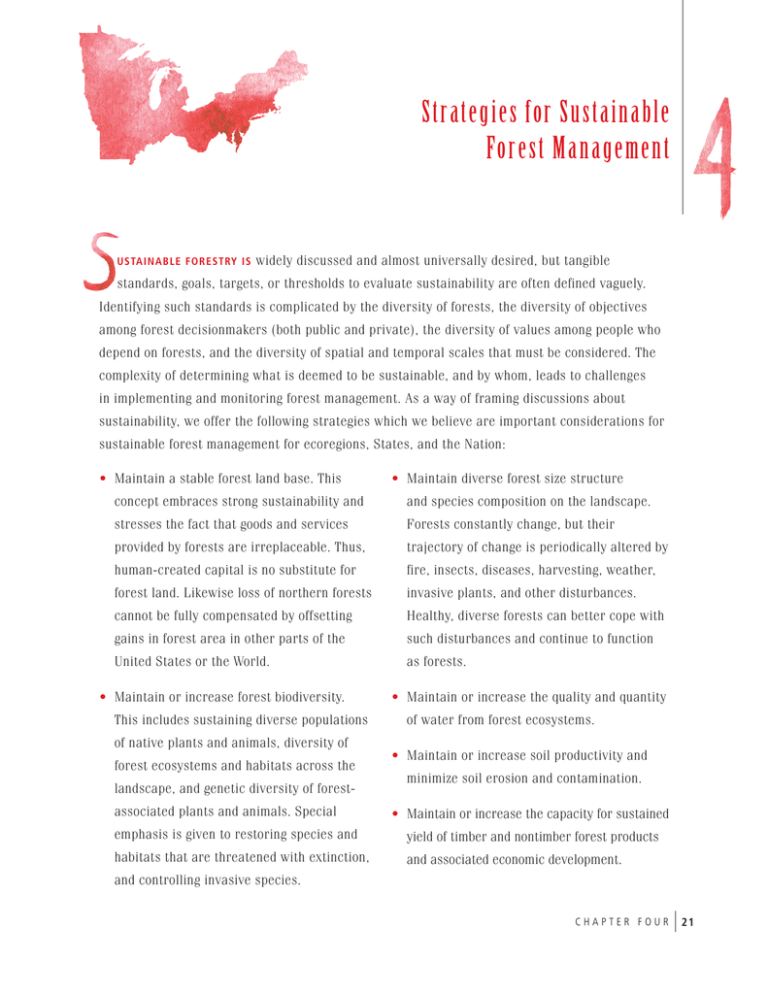Strategies for Sustainable Forest Management
advertisement

Strategies for Sustainable Forest Management USTAINABLE FORESTRY IS widely discussed and almost universally desired, but tangible standards, goals, targets, or thresholds to evaluate sustainability are often defined vaguely. Identifying such standards is complicated by the diversity of forests, the diversity of objectives among forest decisionmakers (both public and private), the diversity of values among people who depend on forests, and the diversity of spatial and temporal scales that must be considered. The complexity of determining what is deemed to be sustainable, and by whom, leads to challenges in implementing and monitoring forest management. As a way of framing discussions about sustainability, we offer the following strategies which we believe are important considerations for sustainable forest management for ecoregions, States, and the Nation: • Maintain a stable forest land base. This • Maintain diverse forest size structure concept embraces strong sustainability and and species composition on the landscape. stresses the fact that goods and services Forests constantly change, but their provided by forests are irreplaceable. Thus, trajectory of change is periodically altered by human-created capital is no substitute for fire, insects, diseases, harvesting, weather, forest land. Likewise loss of northern forests invasive plants, and other disturbances. cannot be fully compensated by offsetting Healthy, diverse forests can better cope with gains in forest area in other parts of the such disturbances and continue to function United States or the World. as forests. • Maintain or increase forest biodiversity. This includes sustaining diverse populations of native plants and animals, diversity of forest ecosystems and habitats across the landscape, and genetic diversity of forestassociated plants and animals. Special • Maintain or increase the quality and quantity of water from forest ecosystems. • Maintain or increase soil productivity and minimize soil erosion and contamination. • Maintain or increase the capacity for sustained emphasis is given to restoring species and yield of timber and nontimber forest products habitats that are threatened with extinction, and associated economic development. and controlling invasive species. C hap t e r F o ur 21 • Maintain or increase forest-based employment Many readers will note that these strategies and community stability. Commercial forest cannot all be pursued equally, and pursuing some operations may be the most economical means will require sacrificing the extent to which others of altering forest structure and composition can be pursued. Tradeoffs and compromises are in ways that are essential to achieving other inevitable in striving for sustainable forests. goals such as habitat restoration, hazardous Sustainable forest management requires careful fuel reduction, or invasive species mitigation. thought about the full range of benefits and • Maintain or enhance the quantity and quality of forest recreation and other opportunities for people to experience forests. • Maintain a system of institutions, policies, regulations, and incentives that support forest sustainability at multiple spatial scales. consequences associated with management actions or inaction. Sustainable forest management is complicated by the multiple benefits and the large temporal and spatial scales that must be considered. For example, short-term decisions about forest sector employment and harvest practices can • Increase environmental literacy and engage have long-term effects on biodiversity. Similar a wide range of stakeholders in sustainable tradeoffs can arise across large spatial scales; forest management one State’s effort to increase the area of forest reserved for wildlife habitat diversity could transfer timber harvesting to other States or to other nations and alter habitat diversity or sustained timber yield there. Urban and rural forests provide many of the same ecosystem services, but differ in the type and number of interactions with people. 22 F O R ESTS O F T H E NO R T H E R N U N I TE D ST A TES Strong and Weak Sustainability Sustainability can be further classified into weak and strong sustainability (Pearce et al. 1994), with capital existing in three forms: natural, human, and human-made. WEAK SUSTAINABILITY— Only concerned about the total capital value (natural + human + human-made) allowing for substitution among the three forms. Human-made or manufactured capital of equal value can take the place of natural capital lost as a result of development. As long as future generations are endowed with an amount of total capital that is not less than that of the current generation, the conditions of weak sustainable development are satisfied. STRONG SUSTAINABILITY— Not merely concerned about keeping the aggregate stocks of capital constant, but also requiring maintenance and enhancement of natural capital levels (ecological assets and environmental quality) because the functions performed cannot be duplicated by manufactured capital. C hap t e r F o ur 23 One of the most significant contributions an assessment such as this can make is to provide the context and data needed to facilitate discussions about sustainable forest management. This assessment provides information at different spatial and temporal scales to support discussion of forest policy and management options available. Choosing among options, making tradeoffs among desirable outcomes, finding the most effective or most equitable solution, or maximizing a single outcome knowing it comes at the expense of other potential achievements: this is the work of society. These issues will be resolved through discourse, legislation, changes to policies, purchases made and forgone, opinions expressed, and investments made. Our hope with this assessment, and the other products developed as part of the Northern Forest Futures Project, is that society does so from a rich understanding of the current state of northern forests and their possible futures. Forest conditions today are influenced by events that took place many decades ago. Likewise, management decisions we make now will have long-term consequences for future generations. 24 F O R ESTS O F T H E NO R T H E R N U N I TE D ST A TES

